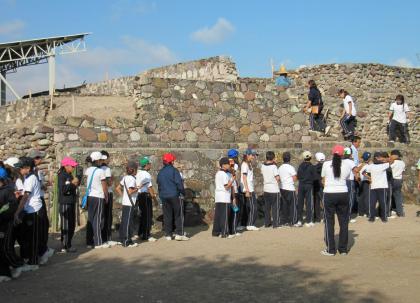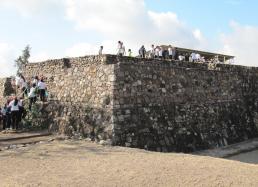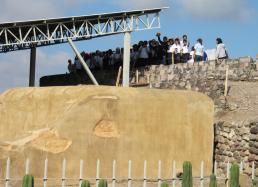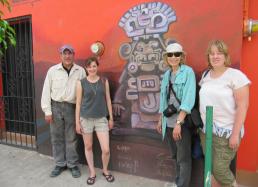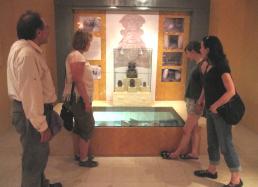6: Preserving Cultural Heritage
One of the key prospects of shifting our efforts to Lambityeco during the years going forward is that there is an existing official archaeological zone that features a sector of the site. More significantly, INAH (Mexico’s Institute of Anthropology and History) has tentative plans to expand this public area at the site.
Unfortunately, if the truth be told, Lambityeco doesn’t seem to attract a major tourist presence now, possibly in part because the zone is relatively small compared to others in the Valley of Oaxaca. At the same time, the archaeological zone at Lambityeco has a key asset—its location! Situated just a quick turn off of the Pan-American Highway, thousands of cars and many tourists travel right past the site on a daily basis.
With the new super-highway (high-speed toll road) to the Pacific Coast soon to be finished, even more vehicles will be going by Lambityeco on the way to the new road. With a larger archaeological zone and a greater number of archaeological insights to relate, Lambityeco (a grand and fascinating site) has the potential to become a far better public draw.
Presently, we’re working (and have tentative plans to continue) as the scientific team at the site, in such a way that INAH would build on our efforts and findings, consolidating and reconstructing the excavated parts of the site with the aim of expanding and enhancing the current archaeological zone.
The educational and pedagogical goals of such a program are key to reach the people of the region, especially the young people (see above image and Photos #1 & #2 below), to perk and gird their understanding and appreciation of the Valley of Oaxaca’s rich cultural past.
Archaeologists around the world are taught about (and are familiar with) the prehispanic record of this region that hosts possibly the world’s earliest corn, one of Mesoamerica’s first cities, and potentially the richest tomb (Monte Albán Tomb 7) found in the Americas.
But as with many parts of the world, the very peoples who are descendant from this tradition are barely familiar with it. Through education, the pride and awareness in local histories and culture can be enhanced, built, and cultivated. Ironically, only in that way can more of the material/archaeological record of that history be saved and curated before it’s destroyed at the jaws of bulldozers and other destructors of modernity (as just sadly occurred to an important Maya temple in Belize that was mined for road fill).
For Linda Nicholas and me, the chance to study at Lambityeco is more than just a great opportunity to examine the peaks and valleys of the early civilization centered at Monte Albán and discover how these cycles affected the lives of the people who lived in the region at that time. It’s a chance to present, contextualize, and help explain Oaxaca’s colorful past to the people who are Oaxaca’s present, as well as many others.
With this in mind, it was a great pleasure to steal a few hours today to take our North American team (see Photos #3 & #4 below) to view the impressive, albeit small, community museum in Santiago Matatlán that includes exhibitions of the key findings that we made at El Palmillo (1997, 1999-2008). We noticed that the museum (which opened last September) is now open five days per week (Wednesday to Sunday), whereas it was open only on weekends last winter.
If you’re traveling to Oaxaca, try to leave time to visit this museum as an example of both the richness of the region’s deep history, as well as a testimony to what can be accomplished when a local community takes great pride in (and chooses to share) its culture, history, and traditions.
More soon,
Gary

